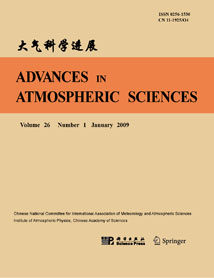| [1] |
FENG Juan*, CHEN Wen,
2014: Interference of the East Asian Winter Monsoon in the Impact of ENSO on the East Asian Summer Monsoon in Decaying Phases, ADVANCES IN ATMOSPHERIC SCIENCES, 31, 344-354.
doi: 10.1007/s00376-013-3118-8
|
| [2] |
LI Xiaofeng, LI Jianping, Xiangdong ZHANG,
2013: A Two-way Stratosphere-Troposphere Coupling of Submonthly Zonal-Mean Circulations in the Arctic, ADVANCES IN ATMOSPHERIC SCIENCES, 30, 1771-1785.
doi: 10.1007/s00376-013-2210-4
|
| [3] |
SONG Yaoming, GUO Weidong, ZHANG Yaocun,
2009: Numerical Study of Impacts of Soil Moisture on the Diurnal and Seasonal Cycles of Sensible/Latent Heat Fluxes over Semi-arid Region, ADVANCES IN ATMOSPHERIC SCIENCES, 26, 319-326.
doi: 10.1007/s00376-009-0319-2
|
| [4] |
Chen Wen, Hans-F. Graf, Huang Ronghui,
2000: The Interannual Variability of East Asian Winter Monsoon and Its Relation to the Summer Monsoon, ADVANCES IN ATMOSPHERIC SCIENCES, 17, 48-60.
doi: 10.1007/s00376-000-0042-5
|
| [5] |
YAN Hongming, YANG Hui, YUAN Yuan, LI Chongyin,
2011: Relationship Between East Asian Winter Monsoon and Summer Monsoon, ADVANCES IN ATMOSPHERIC SCIENCES, 28, 1345-1356.
doi: 10.1007/s00376-011-0014-y
|
| [6] |
LI Fei, WANG Huijun,
2012: Predictability of the East Asian Winter Monsoon Interannual Variability as Indicated by the DEMETER CGCMS, ADVANCES IN ATMOSPHERIC SCIENCES, 29, 441-454.
doi: 10.1007/s00376-011-1115-3
|
| [7] |
Se-Hwan YANG, LU Riyu,
2014: Predictability of the East Asian Winter Monsoon Indices by the Coupled Models of ENSEMBLES, ADVANCES IN ATMOSPHERIC SCIENCES, 31, 1279-1292.
doi: 10.1007/s00376-014-4020-8
|
| [8] |
ZENG Gang, Wei-Chyung WANG, SUN Zhaobo, LI Zhongxian,
2011: Atmospheric Circulation Cells Associated with Anomalous East Asian Winter Monsoon, ADVANCES IN ATMOSPHERIC SCIENCES, 28, 913-926.
doi: 10.1007/s00376-010-0100-6
|
| [9] |
Wu Bingyi, Wang Jia,
2002: Possible Impacts of Winter Arctic Oscillation on Siberian High, the East Asian Winter Monsoon and Sea-Ice Extent, ADVANCES IN ATMOSPHERIC SCIENCES, 19, 297-320.
doi: 10.1007/s00376-002-0024-x
|
| [10] |
Hoffman H. N. CHEUNG, Wen ZHOU,
2016: Simple Metrics for Representing East Asian Winter Monsoon Variability: Urals Blocking and Western Pacific Teleconnection Patterns, ADVANCES IN ATMOSPHERIC SCIENCES, 33, 695-705.
doi: 10.1007/s00376-015-5204-6
|
| [11] |
Jiapeng MIAO, Tao WANG, Huijun WANG, Yongqi GAO,
2018: Influence of Low-frequency Solar Forcing on the East Asian Winter Monsoon Based on HadCM3 and Observations, ADVANCES IN ATMOSPHERIC SCIENCES, 35, 1205-1215.
doi: 10.1007/s00376-018-7229-0
|
| [12] |
WEI Ke, BAO Qing,
2012: Projections of the East Asian Winter Monsoon under the IPCC AR5 Scenarios Using a Coupled Model: IAP-FGOALS, ADVANCES IN ATMOSPHERIC SCIENCES, 29, 1200-1214.
doi: 10.1007/s00376-012-1226-5
|
| [13] |
LI Fei, WANG Huijun,
2013: Relationship between Bering Sea Ice Cover and East Asian Winter Monsoon Year-to-Year Variations, ADVANCES IN ATMOSPHERIC SCIENCES, 30, 48-56.
doi: 10.1007/s00376-012-2071-2
|
| [14] |
ZHANG Ziyin, GUO Wenli, GONG Daoyi, Seong-Joong KIM,
2013: Evaluation of the Twentieth Century Reanalysis Dataset in Describing East Asian Winter Monsoon Variability, ADVANCES IN ATMOSPHERIC SCIENCES, 30, 1645-1652.
doi: 10.1007/s00376-012-2226-1
|
| [15] |
Wen CHEN, Lin WANG, Juan FENG, Zhiping WEN, Tiaojiao MA, Xiuqun YANG, Chenghai WANG,
2019: Recent Progress in Studies of the Variabilities and Mechanisms of the East Asian Monsoon in a Changing Climate, ADVANCES IN ATMOSPHERIC SCIENCES, 36, 887-901.
doi: 10.1007/s00376-019-8230-y
|
| [16] |
LI Qiaoping, DING Yihui, DONG Wenjie, YAN Guanhua,
2007: A Numerical Study on the Winter Monsoon and Cold Surge over East Asia, ADVANCES IN ATMOSPHERIC SCIENCES, 24, 664-678.
doi: 10.1007/s00376-007-0664-y
|
| [17] |
Wen CHEN, Renhe ZHANG, Renguang WU, Zhiping WEN, Liantong ZHOU, Lin WANG, Peng HU, Tianjiao MA, Jinling PIAO, Lei SONG, Zhibiao WANG, Juncong LI, Hainan GONG, Jingliang HUANGFU, Yong LIU,
2023: Recent Advances in Understanding Multi-scale Climate Variability of the Asian Monsoon, ADVANCES IN ATMOSPHERIC SCIENCES, 40, 1429-1456.
doi: 10.1007/s00376-023-2266-8
|
| [18] |
Tae-Won PARK, Jee-Hoon JEONG, Chang-Hoi HO, Seong-Joong KIM,
2008: Characteristics of Atmospheric Circulation Associated with Cold Surge Occurrences in East Asia: A Case Study During 2005/06 Winter, ADVANCES IN ATMOSPHERIC SCIENCES, 25, 791-804.
doi: 10.1007/s00376-008-0791-0
|
| [19] |
LI Lin, LI Chongyin, PAN Jing, TAN Yanke,
2012: On the Differences and Climate Impacts of Early and Late Stratospheric Polar Vortex Breakup, ADVANCES IN ATMOSPHERIC SCIENCES, 29, 1119-1128.
doi: 10.1007/s00376-012-1012-4
|
| [20] |
CHEN Shangfeng, CHEN Wen, WEI Ke,
2013: Recent Trends in Winter Temperature Extremes in Eastern China and their Relationship with the Arctic Oscillation and ENSO, ADVANCES IN ATMOSPHERIC SCIENCES, 30, 1712-1724.
doi: 10.1007/s00376-013-2296-8
|















 AAS Website
AAS Website 
 AAS WeChat
AAS WeChat 
 DownLoad:
DownLoad: